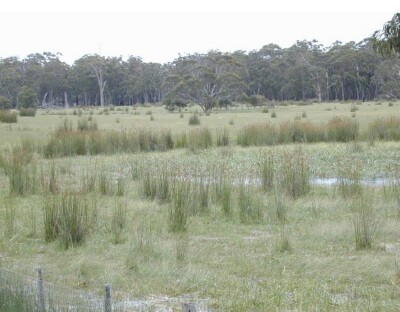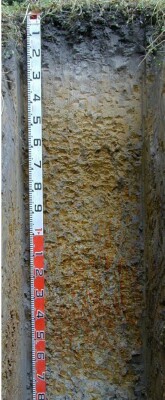GHF03c
Location:
Australian Soil Classification: Ferric, Yellow CHROMOSOL
General Landscape Description: Undulating Plain
Land Unit: Follet Dunes and Plains
Geology: Quaternary aeolian
General Land Unit Description: The majority of this land unit falls south of the Kanawinka fault. This land unit comprises areas with deep sand deposits. The residual landscape is thought to be influenced by the retreat of the Murray Sea which left stranded beach ridges oriented south west–north east. These were subsequently covered by superficial sand sheets in later depositional phases, which formed the landscape we see today.
The major landforms in this land unit are dunes and swales. Podosols and Kurosols or Chromosols are the major soil types found on the dunes and rises. Podosols are soils with a ‘coffee rock’ layer (refer to photograph below). The Kurosols or Chromosols tend to have a deep sandy topsoil over the clay. The common soil types on the swales are black cracking clay (Vertosols) or Grey Sodosols. Some Ferric Kurosols or Chromosols can also occur on the swales or lower slopes of the dunes.

Soil Profile Morphology
Surface
| A1 | 0-12 cm | Very dark greyish brown (10YR3/2) sandy loam; single grain structure; very weak consistence when dry; many medium roots; clear and smooth transition to: |  |
| A2 | 12-20 cm | Yellow (10YR7/6) sand; single grain structure; loose consistence when dry; many medium ferruginous nodules; many medium roots; clear and smooth transition to: | |
| Subsoil | |||
| Bs | 20-25 cm | Yellow (10YR7/6) sand; single grain structure; loose consistence when dry; very many coarse ferruginous nodules; unable to assess macroporosity due to presence of many segregations; few very fine roots; sharp and smooth transition to: | |
| B21 | 25-75 cm | Brownish yellow (10YR6/8) with common medium faint yellowish red (5YR5/8) mottles, light clay; moderate polyhedral structure (20-50 mm) parting to moderate polyhedral structure (10-20 mm); firm consistence when moderately moist; common very fine macropores; areal porosity 0.05%; few very fine roots; diffuse and smooth transition to: | |
| B22 | 75-120 cm | Brown (10YR5/8) with many medium prominent light grey (10YR7/2) and red (2.5YR4/8) mottles, light medium clay; moderate polyhedral structure (20-50 mm) parting to strong polyhedral structure (10-20 mm); firm consistence when moderately moist; few very fine macropores; areal porosity 0.01%; few very fine roots; diffuse and smooth transition to: | |
| B3 | 120-170 cm | Light grey (10YR7/1) with common coarse prominent brownish yellow (10YR6/8) and red (2.5YR4/6) mottles, light medium clay; moderate polyhedral structure (20-50 mm) parting to moderate polyhedral structure (10-20 mm); firm consistence when moderately moist; few very fine macropores; areal porosity 0.01%; no roots observed. | |
| 170-400 cm | Grey heavy clays with pockets of red fine sandy clay, coarsely structured with slickensides, live roots observed to 300 cm, remnant roots observed to 400 cm. | ||
Profile Described By: Ian Sargeant and Paul Feikema, 11th December 2000.


